
Kiandra, New South Wales
Encyclopedia

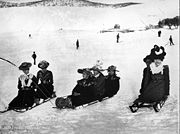
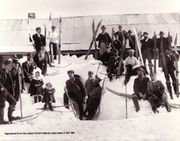
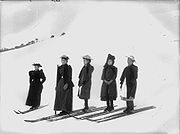

Gold mining
Gold mining is the removal of gold from the ground. There are several techniques and processes by which gold may be extracted from the earth.-History:...
town and the birthplace of Australian skiing. The town is situated in the Snowy Mountains
Snowy Mountains
The Snowy Mountains, known informally as "The Snowies", are the highest Australian mountain range and contain the Australian mainland's highest mountain, Mount Kosciuszko, which reaches 2,228 metres AHD, approximately 7310 feet....
of New South Wales
New South Wales
New South Wales is a state of :Australia, located in the east of the country. It is bordered by Queensland, Victoria and South Australia to the north, south and west respectively. To the east, the state is bordered by the Tasman Sea, which forms part of the Pacific Ocean. New South Wales...
, Australia
Australia
Australia , officially the Commonwealth of Australia, is a country in the Southern Hemisphere comprising the mainland of the Australian continent, the island of Tasmania, and numerous smaller islands in the Indian and Pacific Oceans. It is the world's sixth-largest country by total area...
, in the Snowy River Shire inside the Kosciuszko National Park
Kosciuszko National Park
Kosciuszko National Park covers 690,000 hectares and contains mainland Australia's highest peak, Mount Kosciuszko for which it is named, and Cabramurra the highest town in Australia...
. Its name is a corruption of Aboriginal 'Gianderra' for 'sharp stones for knives'. It was earlier called Gibson's Plains, named after Dr. Gibson, a settler in the district in 1839. For a Century (until the establishment of Cabramurra), Kiandra was Australia's highest town.
Kiandra lies approximately 90 kilometres (55.9 mi) north-west of Cooma
Cooma, New South Wales
-Education: is Cooma's only public high school, it serves the town and seven of the neighbouring rural towns and villages such as Berridale, Jindabyne, Nimmitabel, Bredbo and Dalgety....
on the Snowy Mountains Highway
Snowy Mountains Highway
The Snowy Mountains Highway is a state highway in New South Wales, Australia which traverses the Snowy Mountains.The highway runs across the highland region in the southern part of the State. It starts at its junction with the Hume Highway near Gundagai...
between Adaminaby and Talbingo. It sits at 1400 metres (4,593.2 ft) above sea level and is situated on a high, treeless ridge, on the banks of the Eucumbene River
Eucumbene River
The Eucumbene River rises in the northern part of the Kosciuszko National Park in the Snowy Mountains of New South Wales, Australia, and flows south. Its flow is blocked by Eucumbene Dam, the largest dam in the Snowy Mountains Scheme...
, which is snow-covered during winter and is subject to high winds.
Goldrush
In November 1859, gold was discovered by mountain cattlemen, the Pollock brothers, and by March 1860, some 10,000 miners and storekeepers had raced to the scene. Initial returns were very good. A 9 kg nugget was discovered in river deposits under what became known as New Chum Hill. Kiandra post officePost office
A post office is a facility forming part of a postal system for the posting, receipt, sorting, handling, transmission or delivery of mail.Post offices offer mail-related services such as post office boxes, postage and packaging supplies...
opened on 1 June 1860 and it is estimated that the area at its peak accommodated around 15,000 people, served by 25 stores, 13 bakers, 16 butchers, 14 pubs, several banks and four blacksmiths. Nevertheless, by 1861, the Sydney Morning Herald was reporting a "mass exodus" and the easy pickings were exhausted.
Significant numbers of Chinese people worked the Kiandra goldfields. Chinese miners built Three Mile Dam in 1882 to assist with sluicing operations at "New Chum Hill". The scenic lake still exists and now supplies Selwyn Snowfields
Selwyn snowfields
Selwyn Snowfields is a small ski resort in the northern part of the Snowy Mountains of New South Wales, Australia, in the Snowy River Shire and Kosciuszko National Park...
with its snow-making water requirements. Wikipedia's Chinese site lists Kiandra as 奇安德拉(Qi An De La).
The last mining operations finally ceased around 1905. Official total production recorded was 48 676 kg.
In 1890 the second courthouse to be built in the township was constructed. The building included police barracks and was used more for its police rather than court function. It remained Kiandra's police station until 1937, later to become the Kiandra Chalet.
A 'battery stamper' and other mining relics recovered locally is situated on the road to Cabramurra below New Chums Hill, close to the NPWS entry booth (which is only attended during the snow season). This stamper was used to crush rock and quartz in order to free the embedded gold.
The Wig and Pen Brewery in Canberra
Canberra
Canberra is the capital city of Australia. With a population of over 345,000, it is Australia's largest inland city and the eighth-largest city overall. The city is located at the northern end of the Australian Capital Territory , south-west of Sydney, and north-east of Melbourne...
commemorates this chapter in Australia's High Country history with a pale golden pilsner beer in the Czech style, named "Kiandra Gold".
Skiing
Kiandra is often isolated by deep snow which made it inaccessible during winter. In 1861, Norwegian miners introduced recreational skiing to the snowbound mining settlement by converting fence posts into skis. Ski races were held annually on Township Hill at Kiandra and Australia's first ski club founded - the Kiandra snow shoe clubKiandra snow shoe club
The club was formed in 1861 by three Norwegians, Elias Gottaas, Soren Torp and Carl Bjerknes on the Kiandra Gold Fields, NSW. This original Kiandra ski club is now recognised as the first snow ski club in the world, it also carries the distinction of being the longest continuously operating...
. The Club has been described as the "Oldest Sporting Ski Club in the World".
At one time, the poet Banjo Paterson
Banjo Paterson
Andrew Barton "Banjo" Paterson, OBE was an Australian bush poet, journalist and author. He wrote many ballads and poems about Australian life, focusing particularly on the rural and outback areas, including the district around Binalong, New South Wales where he spent much of his childhood...
was a vice president. The Club held perhaps the first international ski race carnival in 1908. In 1927, William Hughes, a member of the Club, together with four members of the Ski Club of Australia made the first historic ski traverse from Kiandra to the Hotel Kosciusko. Their eventful journey is retold in Klaus Hueneke's book "Kiandra to Kosciusko" and was commemorated by 150 ski tourers in 1977 in an event organised by the Kosciusko Huts Association. The Club is now based in Perisher and is called the Kiandra Pioneer Ski Club.
The Kiandra courthouse closed as a police stattion in 1937, and was for a time used as a private residence, before becoming the Kiandra Chalet (until 1953) and later the Kiandra Chalet Hotel, The owner of the Chalet ran a ski rope tow. The Chalet closed in 1973 and the building became a Roads Depot building.
Australia's first T-Bar was installed on Township Hill in 1957, but in 1978 , Kiandra's ski lift operations re-located permanently to nearby Selwyn Snowfields
Selwyn snowfields
Selwyn Snowfields is a small ski resort in the northern part of the Snowy Mountains of New South Wales, Australia, in the Snowy River Shire and Kosciuszko National Park...
. The T-Bar remained in operation at Mt Selwyn until the 2009 ski season when it was replaced by the Township Triple Chair (retaining the name "Township" in reference to the Kiandra Township hill run).
The area today
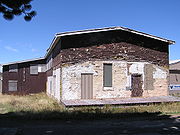
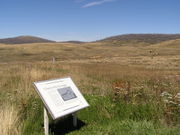

NPWS
NPWS may stand for:* National Parks and Wildlife Service * National Parks and Wildlife Service * National Parks and Wildlife Service...
took over the town and demolished most of its buildings. This decision by the NPWS not to preserve much of the human heritage of the township remains a source of resentment in some quarters in the district to this day. Only four buildings from the former township remain intact, together with a collection of ruins and the historic cemetery. The area retains various other relics of Australian pioneer history
History of Australia (1851-1900)
The History of Australia refers to the history of the indigenous and colonial peoples of the Australian continent during the 50 year period which preceded the foundation of the Commonwealth of Australia in 1901....
, including mining equipment, old gravesites and abandoned diggings.
The remaining buildings at Kiandra are of high heritage value and historical walking trails provides information on the former layout and points of interests of the old town. While two cottages remain in private hands, a third cottage has been restored and can be viewed by the public. The most substantial remaining building is the former courthouse, which was originally constructed in 1890, and which was partially restored by National Parks in 2010 for use as an interpretive centre. The restored court room was officially opened on the 5th of May 2010 with some 150 people present for the ceremony. The later additions to the original courthouse at the rear of the building remain in a state of outward disrepair, although National Parks intend to continue the restoration in stages, aiming to preserve the cultural history of the site across its many previous uses.
Kiandra in print, photography and archaeology
"Historic Kiandra", a history of Kiandra was published by the Kiandra Historical Society to mark the Centenary of the Kiandra Goldrush in 1959, and remains in print. Australian High Country enthusiast Klause Hueneke has written two informative and well illustrated books on the Kiandra region: "Huts of the High Country", 1982 and "Kiandra to Kosciusko", 1987.The Kiandra Pioneer Ski Club recently published a history: "Kiandra : gold fields to ski fields" and "Lapland Snow Shoes in Australia", by Norman W. Clarke
The poet Barcroft Boake
Barcroft Boake
Barcroft Henry Thomas Boake was an Australian poet.Born in Sydney, Boake worked as a surveyor and a boundary rider, but is best remembered for his poetry, a volume of which was published five years after his death....
wrote a poem about skiing at Kiandra, entitled "The Demon Snow Shoes: A Legend of Kiandra".
The Township has been subject to various archaeological studies, including a project by the Australian National University
Australian National University
The Australian National University is a teaching and research university located in the Australian capital, Canberra.As of 2009, the ANU employs 3,945 administrative staff who teach approximately 10,000 undergraduates, and 7,500 postgraduate students...
Department of Archaeology and Anthropology under the direction of Drs Mike Smith, Ken Heffernan and Annie Clark in the mid-1990s. The Kiandra Historical Society remains a useful resource of record for the history of the town.
A number of interesting photographic studies were taken of life at Kiandra, including a series by Charles Kerry
Charles Kerry
Charles Henry Kerry was an Australian photographer noted for his photographs that contributed to the development of the Australian national psyche and romance of the Bush.- Early life and career :...
, and a scene of Chinese miners near the Township.
The 2011 time travel/science fiction adventure novel Falling into History, by Peter Fleming, is partially set in Kiandra.
Climate
Climate statistics were compiled at the Kiandra Chalet site, elevation 1395m, from the year 1866 until 1974. According to the Bureau of Meteorology, the lowest temperature recorded was -17.8 degrees celsius, in July 1965 and again in August 1966. In January 1968, the highest temperature of 32.9 degrees was recorded.For the period 1897-1974, the mean temperature range in January was from maximum 20.7 degrees to minimum 6.1 degrees celsius. In July the figures were: mean maximum 3.9, mean minimum -4.7 degrees.
See also
- Australian gold rushesAustralian gold rushesThe Australian gold rush started in 1851 when prospector Edward Hammond Hargraves claimed the discovery of payable gold near Bathurst, New South Wales, at a site Edward Hargraves called Ophir.Eight months later, gold was found in Victoria...
- Gold miningGold miningGold mining is the removal of gold from the ground. There are several techniques and processes by which gold may be extracted from the earth.-History:...
- List of places with fewer than ten residents
- Skiing in AustraliaSkiing in AustraliaSkiing in Australia takes place in the high country of the states of New South Wales, Victoria and Tasmania, as well as in the Australian Capital Territory, during the Southern Hemisphere winter....
External links
- Kiandra
- The Chinese of Kiandra
- Ski in Kiandra 1860 - old pictures
- Google Map of Kiandra
- Kiandra Historical Society
- History of Selwyn Snowfields
- Sydney Morning Herald Travel Article
- Kiandra Places to See, Sydney Morning Herald
- Monaro Pioneers
- Barcroft Boake poems of Kiandra and surrounds
- Bureau of Meteorolgy, Kiandra Chalet Station

